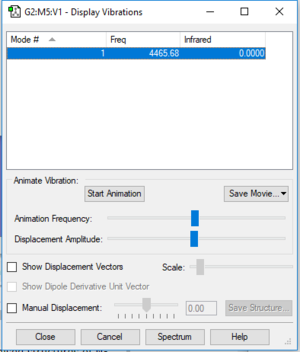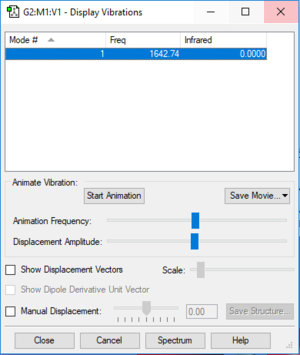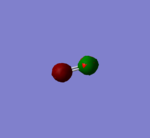Rp318NH3
NH3
Information about the Molecule
Bond angle(Optimised):105.741o Bond length (Optimised):1.01798Å
Table of Optimisation Results of Molecule
| Calculation Method | RB3LYP |
| Basis set | 6-31G(d,p) |
| E(RB3LYP) | -56.5577687 a.u. |
| RMS Gradient Norm | 0.00000485 a.u. |
| Point Group | C3V |
Table Showing the Convergence of Molecule
Item Value Threshold Converged? Maximum Force 0.000004 0.000450 YES RMS Force 0.000004 0.000300 YES Maximum Displacement 0.000072 0.001800 YES RMS Displacement 0.000035 0.001200 YES
The optimisation file is linked to here
Model of Molecule
NH3 |
Vibrations of Molecule

| Wavenumber cm-1 | 1090 | 1694 | 3461 | 3590 |
| Symmetry | A1 | E | A1 | E |
| Intensity Arbitrary units | 145 | 14 | 1 | 0.2 |
The 3N-6 rule shows that there are 6 vibrational modes. Vibrational modes at 1694cm-1 and 3590cm-1 are degenerate.Bending vibrations hasve vibrations at lower frequencies than bond stretch vibrations. In this case the bending vibrations are at 1090cm-1 and 1694cm-1 and the bond streching vibrations are at 3461cm-1 and 3590cm-1.There is a highly symmetrical stretch at 3461cm-1. The mode known as the umbrella mode has the vibration frequecy of 1090cm-1. Three peaks are expected in an experimental spectrum of gaseous ammonia. This is because the symmetrical bond stretch peak will ovelap with the other bond strech peak.
Charge Analysis of Molecule
| H atom | 0.375 |
| N atom | -1.125 |
Charge expected on N is negative while for H it would be positive. This is because N is more electronegative than H threrfore the electrons oin the bond are drawn toward N more.
H2
Information about the Molecule
Bond angle (Optimised):180o Bond length (Optimised):0.600Å
Table of Optimisation Results of Molecule
| Calculation Method | RB3LYP |
| Basis set | 6-31G(d,p) |
| E(RB3LYP) | -1.1785394 a.u. |
| RMS Gradient Norm | 0.00000017 a.u. |
| Point Group | D*H |
Table Showing the Convergence of Molecule
Item Value Threshold Converged? Maximum Force 0.000000 0.000450 YES RMS Force 0.000000 0.000300 YES Maximum Displacement 0.000000 0.001800 YES RMS Displacement 0.000001 0.001200 YES
The optimisation file is linked to here
Model of Molecule
H2 |
Vibrations of Molecule

H2 does not have a peak in the IR spectrum as the molecule is diatomic therefore there is no change in dipole.
Charge Analysis of Molecule
Molecule is a diatomic molecule therefore there is no diference in charge between the two atoms.
N2
Information about the Molecule
Bond angle (Optimised):180o Bond length (Optimised):1.106Å
Table of Optimisation Results of Molecule
| Calculation Method | RB3LYP |
| Basis set | 6-31G(d,p) |
| E(RB3LYP) | -109.5241287a.u. |
| RMS Gradient Norm | 0.00000060 a.u. |
| Point Group | D*H |
Table Showing the Convergence of Molecule
Item Value Threshold Converged? Maximum Force 0.000001 0.000450 YES RMS Force 0.000001 0.000300 YES Maximum Displacement 0.000000 0.001800 YES RMS Displacement 0.000000 0.001200 YES
The optimisation file is linked to here
Model of Molecule
N2 |
Vibrations of Molecule

N2 does not have a peak in the IR spectrum as the molecule is diatomic therefore there is no change in dipole.
Charge Analysis of Molecule
Molecule is a diatomic molecule therefore there is no diference in charge between the two atoms.
N2 Bond Length from Transition Metal Complex
A bond length of N2 was found to be 1.131(8)Å from the transition metal complex (bis(2-(dicyclohexylphosphino)phenyl)(methyl)silyl)-dinitrogen-(trimethylphosphino)-cobalt structure VEJSEL[1]. Bondlength between computational value and experimental value is very close together (both round down to 1.1Å.
Haber-Bosch Reaction Calculation
| E(NH3)=-56.5577687 |
| 2*E(NH3)=-113.1155374 |
| E(N2)=-109.5241287 |
| E(H2)=-1.1785394 |
| 3*E(H2)=-3.5356182 |
| ΔE=2*E(NH3)-[E(N2)+3*E(H2)]=-0.0557905 a.u. |
Converting from a.u. to kjmol-1 gives -146.82kjmol-1. Ammonia product is more stable than the gaseous reactants.
O2
Information about the Molecule
Bond angle (Optimised):180o Bond length (Optimised):1.216Å
Table of Optimisation Results of Molecule
| Calculation Method | RB3LYP |
| Basis set | 6-31G(d,p) |
| E(RB3LYP) | -150.2574243 a.u. |
| RMS Gradient Norm | 0.00007502 a.u. |
| Point Group | D*H |
Table Showing the Convergence of Molecule
Item Value Threshold Converged? Maximum Force 0.000130 0.000450 YES RMS Force 0.000130 0.000300 YES Maximum Displacement 0.000080 0.001800 YES RMS Displacement 0.000113 0.001200 YES
The optimisation file is linked to here
Model of Molecule
O2 |
Vibrations of Molecule

O2 does not have a peak in the IR spectrum as the molecule is diatomic therefore there is no change in dipole.
Charge Analysis of Molecule
Molecule is a diatomic molecule therefore there is no diference in charge between the two atoms.
Molecular Orbitals
References
Marking
Note: All grades and comments are provisional and subject to change until your grades are officially returned via blackboard. Please do not contact anyone about anything to do with the marking of this lab until you have received your grade from blackboard.
Wiki structure and presentation 1/1
Is your wiki page clear and easy to follow, with consistent formatting?
YES
Do you effectively use tables, figures and subheadings to communicate your work?
YES
NH3 0.5/1
Have you completed the calculation and given a link to the file?
YES
Have you included summary and item tables in your wiki?
YES
Have you included a 3d jmol file or an image of the finished structure?
YES
Have you included the bond lengths and angles asked for?
YES, you have a few too many decimal places though!
Have you included the “display vibrations” table?
YES
Have you added a table to your wiki listing the wavenumber and intensity of each vibration?
YES
Did you do the optional extra of adding images of the vibrations?
YES
Have you included answers to the questions about vibrations and charges in the lab script?
YES, most answers are correct. However there are only 2 visible peaks in the spectra of NH3, due to the low intensity of the other 2 peaks. (See infrared column in vibrations table.) All peaks can be distinguished from one another.
N2 and H2 0/0.5
Have you completed the calculations and included all relevant information? (summary, item table, structural information, jmol image, vibrations and charges)
YES, However you have given a bond angle of 180 for N2 and H2, there are no bond angles in diatomic molecules. Bond angles involve exactly 3 atoms.
Crystal structure comparison 0.5/0.5
Have you included a link to a structure from the CCDC that includes a coordinated N2 or H2 molecule?
YES
Have you compared your optimised bond distance to the crystal structure bond distance?
YES
Haber-Bosch reaction energy calculation 1/1
Have you correctly calculated the energies asked for? ΔE=2*E(NH3)-[E(N2)+3*E(H2)]
YES
Have you reported your answers to the correct number of decimal places?
1 or 0 d.p would be more appropriate.
Do your energies have the correct +/- sign?
YES
Have you answered the question, Identify which is more stable the gaseous reactants or the ammonia product?
YES
Your choice of small molecule 3.5/5
Have you completed the calculation and included all relevant information?
YES
Have you added information about MOs and charges on atoms?
YES, very good information, well done. You could have discussed the MOs in a bit more detail.
Independence 0/1
If you have finished everything else and have spare time in the lab you could: Check one of your results against the literature, or Do an extra calculation on another small molecule, or Do some deeper analysis on your results so far
No independent work found.





